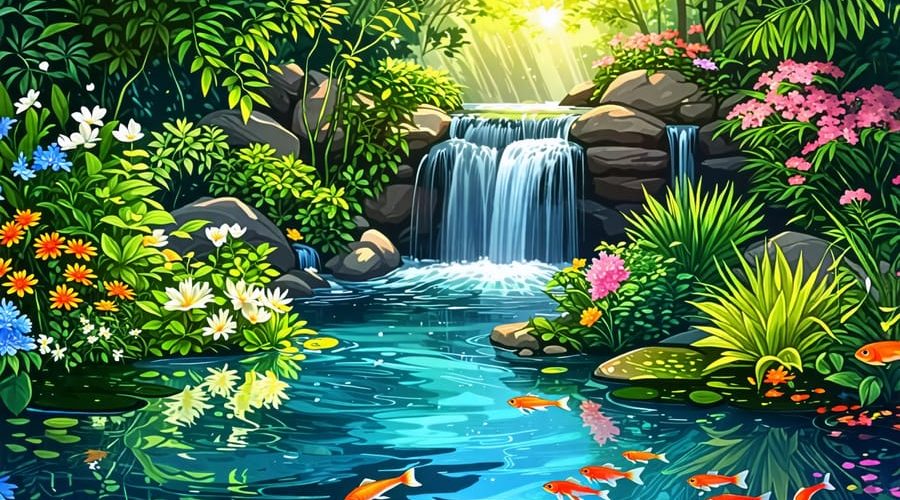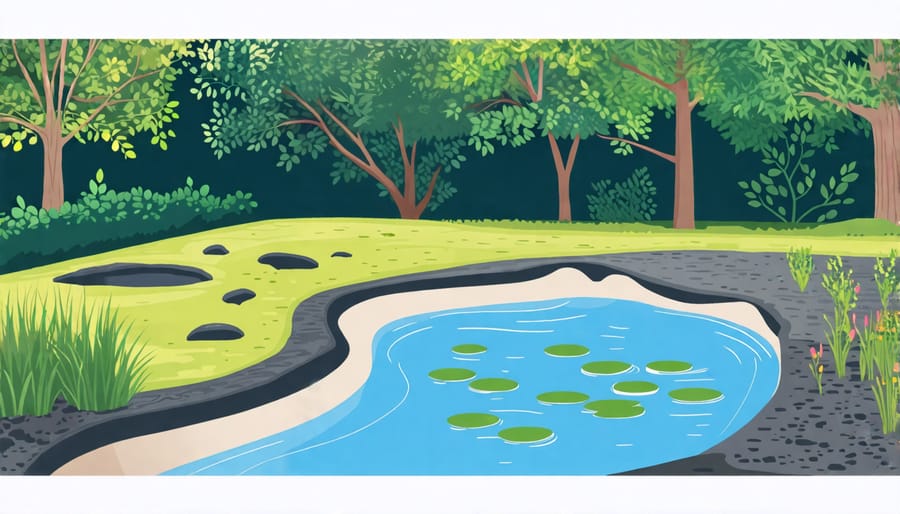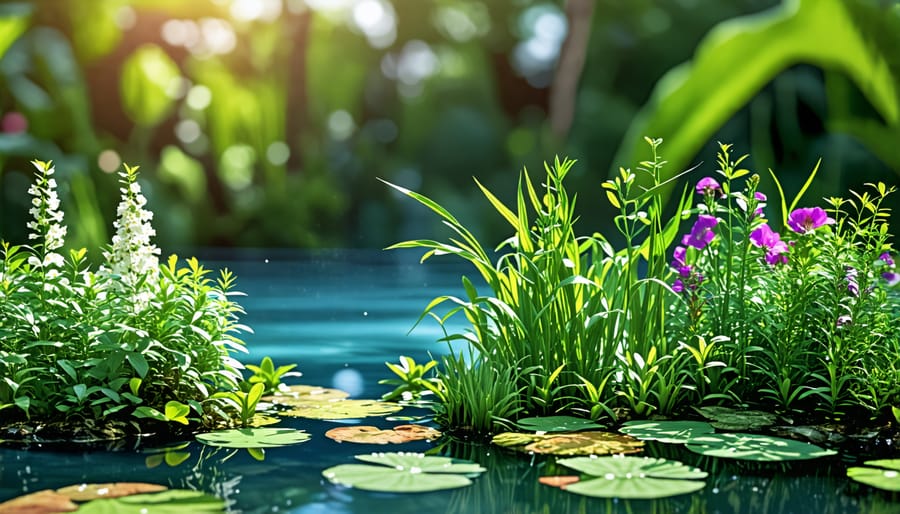
Your Step-by-Step Guide to Building a Thriving Pond Ecosystem
Embark on a remarkable journey into the wonders of nature by creating your very own thriving pond ecosystem. A well-planned pond not only enhances the beauty and tranquility of your outdoor space but also provides a sanctuary for diverse aquatic life to flourish.
With meticulous care and the right knowledge, you can craft a self-sustaining underwater world teeming with vibrant plants, darting fish, and fascinating microorganisms – all working in delicate harmony. From selecting the perfect location and designing the pond’s contours, to choosing compatible flora and fauna and maintaining crystal-clear water quality, every step is an opportunity to deepen your connection with the incredible intricacies of aquatic ecosystems.
Immerse yourself in the art and science of building a captivating pond habitat, and watch in awe as life blooms and balances itself within the oasis you’ve brought forth. Your pond ecosystem project awaits – let the adventure begin!
Planning Your Pond

Choosing the Right Location
When selecting the perfect spot for your pond ecosystem, there are several key factors to consider. First, choose a location that receives a good balance of sunlight and shade throughout the day. This will promote healthy plant growth and prevent excessive algae growth. Next, ensure the site is level and has stable soil to avoid water seepage and structural issues.
Consider the proximity to your home for easy access and maintenance, but also keep in mind the potential for noise from water features. Avoid areas with overhanging trees that may drop leaves and debris into the pond.
Lastly, think about the overall aesthetics and how the pond will integrate with your existing landscape design. Visualize the finished product and select a location that will showcase your pond ecosystem as a beautiful focal point in your outdoor space. With careful consideration of these factors, you’ll be well on your way to creating a thriving and visually stunning pond ecosystem.
Determining Pond Size and Depth
When planning your pond ecosystem, choosing the right size and depth is crucial. Consider your available space, budget, and goals for the pond. As a general rule, a larger pond is easier to maintain as it’s more resilient to environmental changes. For a low-maintenance ecosystem pond, aim for a minimum surface area of 50 square feet and a depth of at least 2 feet.
If you want to keep fish like koi or goldfish, your pond should be at least 3 feet deep to provide a stable environment and protect them from predators. For a more diverse ecosystem with aquatic plants, a depth of 18-24 inches is sufficient.
When designing your pond, include different depth zones to accommodate various plant species and create visual interest. Shallow areas (6-12 inches deep) are perfect for marginal plants, while deeper sections (12-18 inches) can host water lilies and submerged plants.
Remember, the larger your pond, the more stable the ecosystem will be, but it’s essential to find a balance that works for your space and maintenance preferences.
Designing the Pond Layout
When designing your pond layout, let your creativity flow! Sketch out different shapes and sizes to find the perfect fit for your space. Consider incorporating natural elements like rocks, boulders, and driftwood to create a more organic look. Think about how the pond will be viewed from various angles in your yard and plan accordingly.
Don’t forget to include shelves or planting zones around the edges for marginal plants and shallow-water lovers. This will not only add visual interest but also provide valuable habitat for wildlife. If you plan to keep fish, make sure to include deeper areas for overwintering.
Lastly, consider the placement of any waterfalls, streams, or fountains you want to include. These features add movement, sound, and aeration to your pond, enhancing both the aesthetic appeal and the overall health of the ecosystem. With a well-designed layout, your pond will be a stunning focal point in your landscape for years to come.
Constructing the Pond

Excavation and Lining
To create your pond, start by marking out the desired shape and size on the ground. Using a shovel, excavate the area to a depth of at least 2 feet, with shallower shelves around the edges for plants. Remove any sharp rocks or debris from the hole. For a natural clay bottom, compact the soil and check for water retention. Alternatively, lay a protective underlay and durable pond liner, tucking it securely around the edges.
When lining your pond, choose a high-quality rubber or PVC liner that is UV and puncture-resistant. Carefully unfold the liner and place it into the excavated hole, smoothing out any wrinkles. Secure the edges with heavy rocks or by burying them in a trench around the perimeter. Fill the pond gradually with water, adjusting the liner as needed for a snug fit. Once filled, trim any excess liner, leaving about a 1-foot overlap for added stability.
Throughout the process, take your time and work carefully to ensure a stable and leak-proof foundation for your pond ecosystem. With proper excavation and lining, you’ll be well on your way to enjoying a beautiful and thriving aquatic oasis in your backyard.
Adding Pond Features
Adding features like waterfalls and streams can take your pond ecosystem to the next level. A waterfall creates a stunning focal point while aerating the water and promoting beneficial bacteria growth. You can build one using rocks, a pond liner, and a submersible pump. Position the rocks to form a natural-looking cascade, and conceal the liner and pump for a seamless appearance.
Streams add movement and connect different pond areas. Dig a shallow channel, line it with gravel and rocks, and use a pump to circulate water from the pond. Create gentle curves and vary the width for a realistic feel. Consider adding aquatic plants along the edges to soften the look.
Other features to consider include underwater lighting, floating islands, and decorative elements like statues or driftwood. Let your creativity shine, but always prioritize the health and balance of your pond ecosystem. With thoughtful planning and a little effort, you can create a truly stunning aquatic oasis in your own backyard.
Filling and Testing
Once your pond liner is in place, it’s time for the exciting part – filling your pond with water! Grab a garden hose and start filling, keeping an eye out for any wrinkles or folds in the liner. As the water level rises, gently smooth out any imperfections to ensure a clean, leak-free finish.
After filling, let the pond sit for at least 24 hours to check for any sneaky leaks. If you spot a drop in water level, investigate the liner for damage and patch it up with a pond liner repair kit. Once you’ve confirmed your pond is watertight, you’re ready to move on to the fun part – adding plants, fish, and other decorative elements to bring your pond ecosystem to life!
Establishing the Ecosystem
Selecting and Planting Aquatic Flora
When selecting Aquatic Flora for your pond ecosystem, consider a mix of submerged, floating, and emergent plants. Submerged plants like hornwort and anacharis provide oxygen and shelter for fish. For floating options, water lilies and lotus add beauty and shade. Emergent plants such as cattails and rushes filter the water and create a natural look along the edges.
Before planting, ensure your chosen plants are suitable for your pond’s size, depth, and climate. Prepare the planting areas by adding appropriate soil or gravel substrates. Gently remove plants from their containers, loosen the roots, and place them in the designated spots. Secure the plants with stones or weights if necessary. Space the plants adequately to allow for growth and spread. After planting, monitor the plants’ health and prune or divide them as needed to maintain a balanced ecosystem.

Adding Fish and Wildlife
When adding fish to your pond, consider native species that are well-suited to your climate and pond conditions. Koi and goldfish are popular choices, but be mindful of their potential impact on water quality. To attract frogs, turtles, and other wildlife, create shallow areas with hiding spots like rocks and logs. Floating plants provide cover and shade for aquatic creatures. Avoid introducing invasive species that can disrupt the ecosystem balance. Start with a few small fish and gradually build up the population. Monitor water quality regularly and adjust as needed to maintain a healthy environment for your pond’s inhabitants. With careful selection and a balanced approach, you can create a thriving, diverse ecosystem that brings your pond to life.
Promoting Beneficial Bacteria
Beneficial bacteria are the unsung heroes of a thriving pond ecosystem. These microscopic marvels work tirelessly to break down organic matter, purify water, and maintain a healthy balance. To cultivate a robust population of beneficial bacteria, start by providing ample surface area for them to colonize, such as on rocks, gravel, and pond plants. Avoid over-cleaning your pond, as this can disrupt the delicate bacterial colonies. Regularly add beneficial bacteria supplements, especially during seasonal changes or after heavy rainfall. With a little nurturing, these tiny allies will keep your pond crystal clear and teeming with life.
Maintaining Your Pond Ecosystem
Keeping your pond ecosystem thriving requires regular care and attention. Essential ongoing maintenance tasks include monitoring water quality, removing debris, and managing plant growth. Regularly test pH levels and address any imbalances promptly. Skim off fallen leaves and excess organic matter to prevent nutrient buildup. Prune aquatic plants as needed to control their spread and maintain a balanced ecosystem. Periodically clean filters and pumps to ensure optimal water circulation and clarity. Keep an eye out for signs of algae overgrowth or fish health issues, addressing them swiftly. With consistent upkeep, your pond will remain a stunning and vibrant oasis teeming with life. Embrace the joys of tending to your aquatic haven, knowing that each small task contributes to its long-term beauty and well-being.
Conclusion
Creating your own pond ecosystem can be a rewarding and fulfilling experience. By following the steps outlined in this guide, from planning and design to installation and maintenance, you’ll be well on your way to enjoying a beautiful and thriving water feature in your outdoor space. Remember to take your time, do your research, and don’t be afraid to ask for help when needed. With a little patience and dedication, you’ll soon be able to sit back and marvel at the stunning results of your hard work. So what are you waiting for? Grab your tools, unleash your creativity, and dive into the wonderful world of pond ecosystems today!
